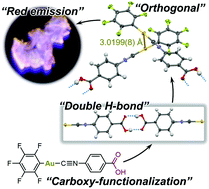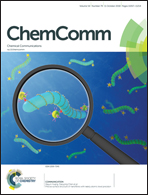A gold isocyanide complex with a pendant carboxy group: orthogonal molecular arrangements and hypsochromically shifted luminescent mechanochromism†
Abstract
The epistatic double hydrogen bonds that arise from the presence of a pendant carboxy group in a gold isocyanide complex result in strong aurophilic interactions in a magenta-emitting polymorph. This is due to the lack of the typically antiparallel dimer arrangements, which often prevent the formation of strong aurophilic interactions. Furthermore, this polymorph shows hypsochromically shifted luminescence mechanochromism.



 Please wait while we load your content...
Please wait while we load your content...